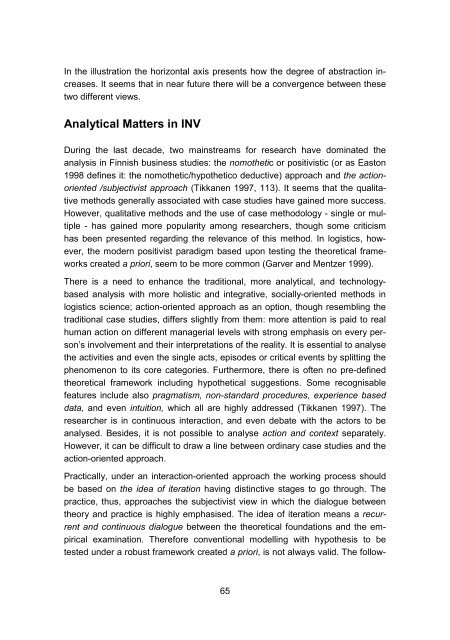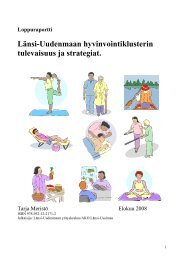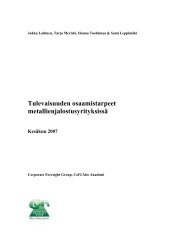849954 sisus
849954 sisus
849954 sisus
You also want an ePaper? Increase the reach of your titles
YUMPU automatically turns print PDFs into web optimized ePapers that Google loves.
In the illustration the horizontal axis presents how the degree of abstraction increases.<br />
It seems that in near future there will be a convergence between these<br />
two different views.<br />
Analytical Matters in INV<br />
During the last decade, two mainstreams for research have dominated the<br />
analysis in Finnish business studies: the nomothetic or positivistic (or as Easton<br />
1998 defines it: the nomothetic/hypothetico deductive) approach and the actionoriented<br />
/subjectivist approach (Tikkanen 1997, 113). It seems that the qualitative<br />
methods generally associated with case studies have gained more success.<br />
However, qualitative methods and the use of case methodology - single or multiple<br />
- has gained more popularity among researchers, though some criticism<br />
has been presented regarding the relevance of this method. In logistics, however,<br />
the modern positivist paradigm based upon testing the theoretical frameworks<br />
created a priori, seem to be more common (Garver and Mentzer 1999).<br />
There is a need to enhance the traditional, more analytical, and technologybased<br />
analysis with more holistic and integrative, socially-oriented methods in<br />
logistics science; action-oriented approach as an option, though resembling the<br />
traditional case studies, differs slightly from them: more attention is paid to real<br />
human action on different managerial levels with strong emphasis on every person’s<br />
involvement and their interpretations of the reality. It is essential to analyse<br />
the activities and even the single acts, episodes or critical events by splitting the<br />
phenomenon to its core categories. Furthermore, there is often no pre-defined<br />
theoretical framework including hypothetical suggestions. Some recognisable<br />
features include also pragmatism, non-standard procedures, experience based<br />
data, and even intuition, which all are highly addressed (Tikkanen 1997). The<br />
researcher is in continuous interaction, and even debate with the actors to be<br />
analysed. Besides, it is not possible to analyse action and context separately.<br />
However, it can be difficult to draw a line between ordinary case studies and the<br />
action-oriented approach.<br />
Practically, under an interaction-oriented approach the working process should<br />
be based on the idea of iteration having distinctive stages to go through. The<br />
practice, thus, approaches the subjectivist view in which the dialogue between<br />
theory and practice is highly emphasised. The idea of iteration means a recurrent<br />
and continuous dialogue between the theoretical foundations and the empirical<br />
examination. Therefore conventional modelling with hypothesis to be<br />
tested under a robust framework created a priori, is not always valid. The follow-<br />
65








